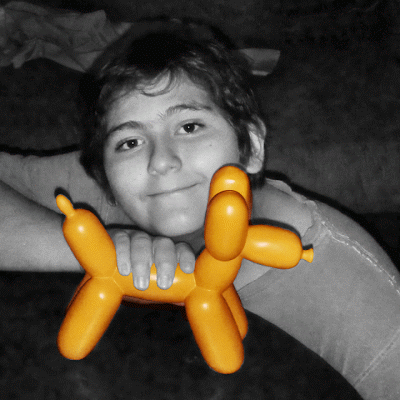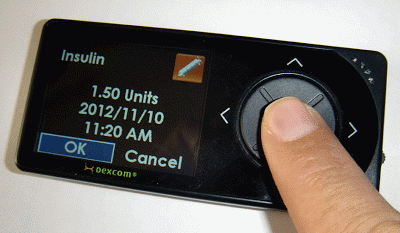Voices in the night
“If a sales rep suggests to you that if the alarm is too low you can set the monitor to vibrate, then set the CGM on a mirror next to a glass of ice water at night (true story!), you know the frickin’ alarm is not loud enough.”
--Beyond Fingersticks
If I’ve said it once, I’ve said it a thousand times: Your CGM alarms must be loud enough to wake the dead so you don’t join them.
So that begs the question: Will the Dexcom G-4 get you any Zombie action?
Well, it’s a hell of a lot better than the Med-T Guardian or their Revel (unless it’s talking to the mySentry, which is delightfully loud). And in many ways, G4 beats Dex 7, but sadly, not in every way.
The G4 comes equipped with what Dex calls “alert profiles.” It’s called a profile, because each of the five options you can choose from applies itself to all alerts, alarms, and prompts. It’s easy, but you can’t mix and match, and you don’t get as much choice as Dex marketing materials might lead you to believe you do. On the bright side, each alert, alarm, or prompt has its own unique sound. The manual says, “This lets you easily identify each alert and alarm and its meaning.” I say, it speaks a unique language you and your family can learn.
But before we get to the profiles, we have to talk about the gorilla. What? You didn’t notice him over there in the corner? How could you miss an 800-pound gorilla in the corner? Yes, the G4 shares a fundamental design flaw with its predecessors: The first alert is vibe only. If you acknowledge it, little Bo Peep never makes a sound. That’s nice for staff meetings, but not so great for 3 a.m. The vibe-first design all but guarantees you’ll miss the first warning late at night. What does that really mean? Well, let’s play a game.
Let’s assume you’ve left your G4 set at the factory defaults, so your low threshold is at 80 mg/dL. Never mind for the moment that there’s a good chance your sugar will get ahead of the CGM readings and you’ll already be below 80 when the alarm goes off. When the system detects an 80, it will vibrate. The audio alarm won’t go off for five more minutes. How low will you be by that time?
Well it depends on how fast you’re dropping. The G4 recognizes two speeds for its optional Advanced Alert for falling glucose—more than 2 mg/dL per minute, or more than 3 mg/dL per minute. At the “slower” rate you’ll be down to 70 mg/dL the first time your Dex squawks at you. At the “faster” rate you’ll be down to 65 mg/dL. Does anybody but me have a problem with this? Does anybody but me think the ice is a little thin under our feet at 65 mg/dL at three fucking a.m.?
Well, this is nothing new, you say. True. Dex Seven was just the same. But the Dex Seven vibe alarm was seismic. It’s hard to describe, but even though it was silent, it was robust enough to wake me up 95% of the time. A week or two ago, I wondered and worried if the new G4’s vibe would wake me from my slumber. I’ve now had enough nocturnal lows to report that, sadly, it’s not. I sleep through almost all of them. On the bright side, the G4’s voice is loud enough that I’ve not yet joined the dead. (It would be pretty creepy if I had, and was still able to blog, huh? I guess I’d have to change the name of the site to LifeAfterDeath—the Zombie Chronicles.)
So why not just move the alarm threshold upwards to a higher number to compensate, you ask? Well, I’d love to, but… Here again, we’re dealing with one of the few short-sighted aspects of the G4’s grand design. I only get one low threshold to choose from. If I choose 90 at night, then I’m stuck with 90 all day, too. And that sets me up for pack of nuisance alarms. Why not reset it every day? Because that would be a frickin’ hassle. I’d forget half the time to change it back when I got up, and forget half the time to change it again when I went to bed. Our devices should serve us, we shouldn’t have to serve them. I wish they’d designed the G4 to go straight to audio at night.
So the vibe sucks, compared to its predecessor. How’s the voice? In a word, charming. One nice feature is a preview function, so you can tentatively set a profile, then run through all the alarms to see what they’ll sound like, and decide if they’re right for you.
The alert profiles are: Vibrate, Soft, Normal, Attentive, and Hyporepeat.
In the Vibe mode the G4 remains silent, signaling you with Morse Code the nature of the alarm. Three short vibes is a low. Two long is a high. And so on. This same pattern of vibes extends across the spectrum as the first alarm in all of the profiles. If you have a “fixed low” at 55 mg/dL (the break-glass-in-case-of-emergency alarm that cannot be disabled) in the Vibrate profile, the G4 will give you four short vibes and then switch to audio in five minutes if you don’t acknowledge it. But let me be clear: It does not do this for garden-variety lows, only for the ultimate “fixed” low. By the way, I think they really missed an opportunity here. Instead of four shorts, I think they should have used three shorts, three longs, followed by three shorts. Yeah. Morse Code for S.O.S.
In the Soft profile (not to be confused with soft-core porn) we get the same vibes plus low beeps after five minutes. How low? Actually, about twice as loud as the almost-impossible-to-hear Medtronic “loud” tones. At the Library of Congress, you’d most definitely hear them. In the subway? Not so much. The tones associated with highs and rises are a higher octave beep than the ones associated with lows and drops, which feature a deeper tone.
In the Normal profile the beeps are louder. These tones are particularly annoying to cats, as it turns out. The alpha cat (a Siamese who likes to cuddle up against my back at the top of my desk chair as I write) just finished tearing my back and neck to shreds as I tested the tones for this column. So hypo cats may be the next big thing. The Dex manual defines the beeps as being either “low” for the Soft profile or “medium” for the Normal profile.
My G4 is set to the Attentive profile. I still get the same set of vibes we’ve seen across the board, but now instead of beeps and tones, I get music. Well, not music so much as melodies. The sounds are fun, spunky, entertaining, and highly communicative confused with communicable). And by that I mean that the sounds Dex has created fit the circumstance. A rise is greeted with a rising sound effect. A fall by a falling sound effect, and so on. They run respectably long, about four seconds each, a much longer commotion that you get out of Soft or Normal beeps; and the volume is pleasingly loud. It wakes me up and night. But, since there are no subways in New Mexico, I can’t tell you whether or not you can hear it on the subway.
The last profile is the Hyporepeat. Don’t get too excited. This mode is merely Normal plus. It uses the medium beeps and adds the “feature” of alarming every five seconds if you drop below 55 mg/dL. The people at the morgue will find this highly annoying.
I think, overall, the G4’s voice and voice options are a huge improvement over the Dex Seven. But I’m still disappointed that the best ever CGM alarm system was way the fuck back in 2005. The original garage door opener Guardian RT had the longest, loudest, fun and funkiest alarms of all.
I thought that technology, like fine wine, was supposed to improve with time.













































